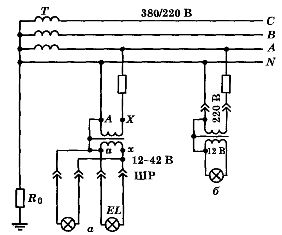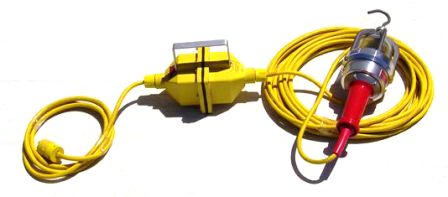Low voltage applications and isolation transformers
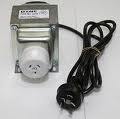
Low voltage sources can be batteries, rectifiers, if necessary, direct current, low power single phase transformers (up to 1 kVA), portable or stationary.
Resistors, chokes, etc. it is unacceptable to use it to lower the voltage in the electrical receiver.
Rice. 1. Stationary (a) and portable (b) transformers for powering low-voltage lamps (12 — 42 V)
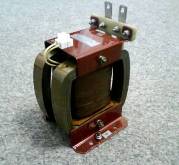 Produced step-down transformers 12 — 42 V low-power secondary voltage (up to 1 kVA) both for stationary installation (for example, on metal-cutting machines and production equipment) and portable (for temporary connection to the network), for example, OSM type transformers.
Produced step-down transformers 12 — 42 V low-power secondary voltage (up to 1 kVA) both for stationary installation (for example, on metal-cutting machines and production equipment) and portable (for temporary connection to the network), for example, OSM type transformers.
The portable transformer must have a flexible mains lead enclosed in a protective sheath made of rubber or polyvinyl chloride and a plug for connection to a socket-outlet installed on the panel in the switchgear or in areas of workshop use.
Isolating transformers
The secondary windings of step-down transformers with a secondary voltage of 12 — 42 V must be grounded, as there is a risk of damage to the transformer with the transition of the higher voltage to the lower side. Such a scheme also has a disadvantage, because in the event of a short circuit to the frame or to the ground in the primary network, the grounding conductors or the neutral conductor receive some voltage relative to the ground for some time until the damaged section is switched off.
All grounded parts, including secondary windings and low voltage circuits, receive the same voltage with respect to ground. This voltage (especially in 380/220 V networks) can significantly exceed the voltage of 42, 36 or 12 V. Meanwhile, it is considered that touching live parts at these voltages is not dangerous.
This shortcoming can be removed by applying so-called separating transformers.
Isolating transformers must be subject to increased requirements to avoid insulation damage inside the transformer with the transition of the primary side voltage to the secondary side (e.g. increased test voltages). Isolating transformers can be used not only with a simultaneous voltage drop, but also as purely isolating, for example 220/220 V, etc.The secondary voltage of the isolating transformers must still be no higher than 380 V.
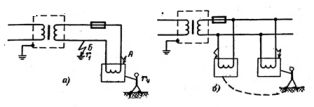
Rice. 2. Switching on the isolation transformer (a) Double circuit in the mains fed through the isolation transformer (b).
The secondary winding of an isolating transformer or electrical receiver must not be grounded. Then (and this is their important advantage!) Touching live parts or a housing with damaged insulation (Fig. 2, point A) does not create a danger, since the secondary network is short and the leakage currents in it with good insulation are negligibly small .
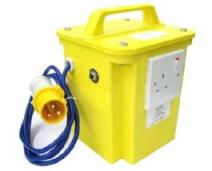 If this short circuit in one phase is not eliminated and insulation occurs in the other phase of the secondary circuit (point B), then the fuse can blow with only a metal connection between points A and B, this will not happen in most cases. A voltage will appear on the body of the electrical receiver relative to ground, which will depend on the ratio of the resistance at point B and the human body (including the resistance of the floor and shoes). This voltage can be dangerous if the person is standing on the ground or on a conductive floor and shoes have little resistance.
If this short circuit in one phase is not eliminated and insulation occurs in the other phase of the secondary circuit (point B), then the fuse can blow with only a metal connection between points A and B, this will not happen in most cases. A voltage will appear on the body of the electrical receiver relative to ground, which will depend on the ratio of the resistance at point B and the human body (including the resistance of the floor and shoes). This voltage can be dangerous if the person is standing on the ground or on a conductive floor and shoes have little resistance.
To reduce the possibility of double faults, no branch network should be connected to the isolation transformers on the secondary side. So, with two or more electrical receivers, it is possible to short circuit them with a connection to ground in two different phases. Such double chains can already lead to defeat. Therefore, each consumer of electrical energy must have his own isolation transformer.
The use of isolation transformers provides a significant improvement in safety conditions compared to supplying power directly from the mains or via step-down transformers with grounded secondary windings.
As in other cases, it is necessary to check the insulation of transformers, electrical receivers and conductors of the secondary network periodically and often enough to rule out single-phase faults.
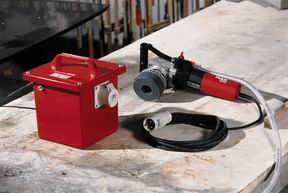
Isolation transformer TT2602

